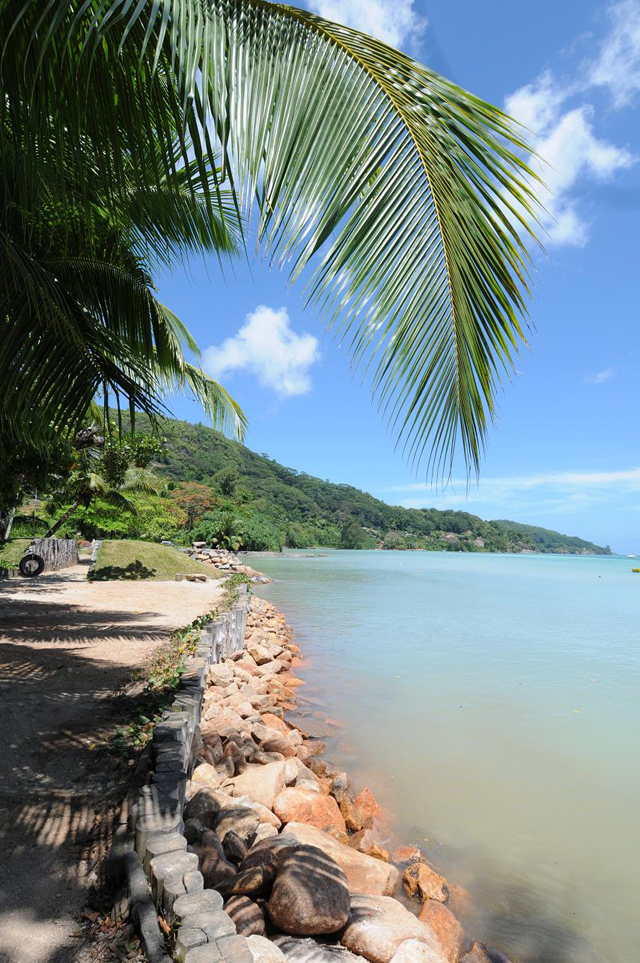$10 million for environment related projects in Seychelles: UNDP-GEF
General |Author: John Lablache, Vidya Gappy and Sharon Uranie | November 4, 2014, Tuesday @ 14:10| 34356 views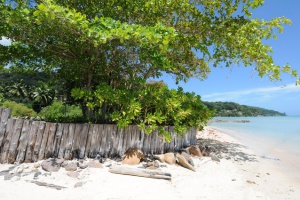
Rehabilitated eroded coastline at Anse La Mouche, in the western part of the Seychelles main island of Mahe. A Six year climate change adaptation project received worth $6.5 million which will focus of flooding and water scarcity on Mahe and Praslin was launched last week. (Patrick Joubert, Seychelles News Agency)
(Seychelles News Agency) - A six year project to support climate change adaptation measures on the Seychelles main and second most populated islands of Mahé and Praslin is underway with a key focus on water scarcity and flooding.
This comes amid climate change projections for Seychelles which shows that rainfall is becoming more irregular with much of the precipitation falling in sharp bursts, causing flooding in the wet season followed by an extended period of drought during the dry season.
The situation is aggravated as the islands’ topography impact on water storage capacity.
Furthermore, the coastal zone is vulnerable to flooding during the wet season and as a consequence of rising sea levels.
Watershed rehabilitation is expected to be an important component of the project.
Mare aux Cochons, a ravine near Mahé’s north-west coast and Mont Plaisir in the south, are being set aside for watershed rehabilitation.
The $ 6.5 million project launched last Thursday in the Seychelles capital of Victoria is being funded by the Global Environment Facility (GEF) and will be implemented by the Seychelles government and the United Nations Development Programme (UNDP) through the GOS-UNDP-GEF programme coordination unit.
The Director General for Climate Affairs, Adaptation and Information at the Seychelles Ministry of Environment and Energy, Alain Decommarmond told the stakeholders that "invasive plants, which use a significant share of water in the catchment areas are to be replaced by endemic species to ensure maximum yields from rivers for domestic use."
The project will also be focussing on coastal rehabilitation, for which North-East-Point, in north Mahé and Anse Royale in the south have been designated for rehabilitation, possibly by rock armouring.
Over recent years, both areas have become increasingly vulnerable to flooding, sea level rise and increased storm surges from cyclonic activity in the western Indian Ocean.
|
|
| The rehabilitated coastline at Anse La Mouche (western part of Mahe) which has now also been turned into a recreational park. Rehabilitation work will be done at North-East-Point, in north Mahé and Anse Royale in the south as part of the climate adaptation project. (Patrick Joubert, Seychelles News Agency) Photo License: CC-BY |
“Seychelles has worked hard to protect its biodiversity and to maintain the scenic values that underpins the tourism industry. However, outside protected areas, unplanned and often fragmented development activities without due consideration to climate change have taken place which have led to degradation of ecosystems, and associated impacts on ecosystem services. The EBA project (Ecosystem Based Adaptation to Climate in Seychelles) seeks to reverse and mitigate some of the adverse effects and to address long terms sustainability as it will focus on building capacity at all levels,” said Simon Springett, UN Resident Coordinator and UNDP Resident Representative.
The 6.5 million climate adaptation project which is the largest ever GOS-UNDP-GEF project in Seychelles is one of three projects recently added to the growing portfolio of joint projects focussing on environmental protection, climate change adaptation, energy efficiency and renewable energy.
Agreements for all three which amounts to $10 million were signed last week at the Seychelles Ministry of Foreign Affairs.
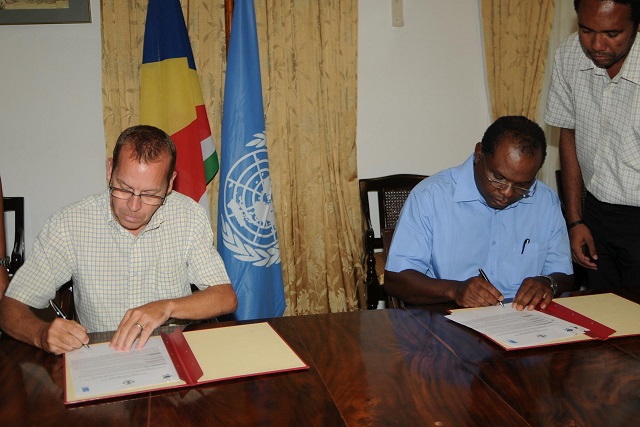 |
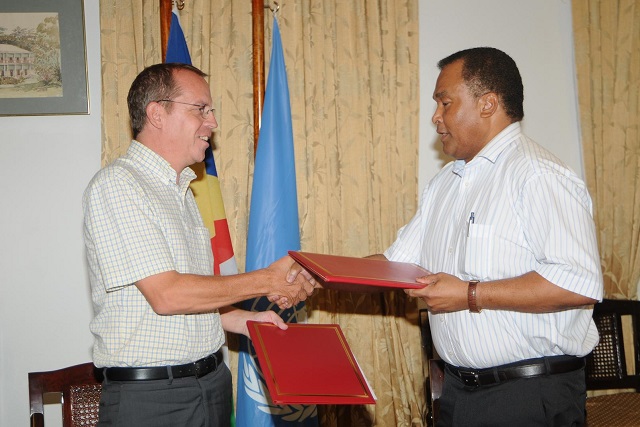 |
|
The agreements were signed by the United Nations Resident Coordinator and UNDP Resident Representative for Mauritius and Seychelles, Simon Springett, the Principal Secretary for Environment and Energy, Wills Agricole, and the Ministry’s Special Advisor, Didier Dogley. (Joena Bonnelame, Seychelles News Agency) Photo License: CC-BY |
The second project or the Outer Island project will focus on biodiversity conservation and supporting new protected areas on some outer islands.
The outer islands of Seychelles constitute more than half of 115 islands within the archipelago and to date only two the Aldabra Special Reserve and the African Banks are fully established protected areas.
Amongst other outcomes the outer island project is expected to see the establishment of new protected areas amongst the outer islands.
After six years of study and evaluation, the Government of Seychelles, the United Nation Development Fund, UNDP and the Global Environment Facility, GEF, recently came up with a list of the Seychelles outer islands that need to be protected.
These islands located at distances of between 230 to 1,150 kilometres from the main island of Mahe are Alphonse Group, Desroches, Poivre, Farquhar and privately owned islands of D’Arros and St. Joseph.
That project, worth almost $ 2 million that will run for five years will see the government of Seychelles team up with non-governmental organisations and other partners in order to implement a legally established programme for protected areas.
Through this programme, the biodiversity of the listed islands will be assessed and monitored with conservation program developed on each islands.
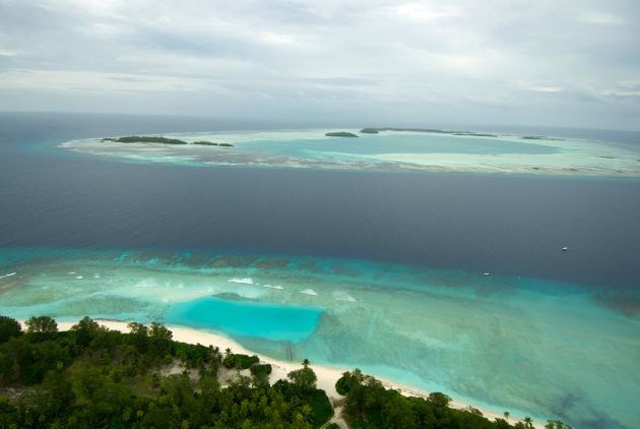 |
|
D’Arros Island and St Joseph Attol lie in the remote Western India Ocean about 250km form Mahe´ the most inhabited island in the Seychelles. Along with Alphonse Group, Desroches, Poivre and Farquhar, the five outer islands will see the implementation of a legally established programme for protected areas within the next five years. (Save Our Seas Foundation, Rainer von Brandis) Photo license: CC-BY 3.0 |
The third project is linked to the promotion of renewable energy technologies in Seychelles, where 90 percent of the primary energy supply comes from imported fuel, accounting for 12 percent of total government expenditure.
A market for energy- efficient appliances is just starting to develop in Seychelles, linked mainly to rising electricity costs for most consumers.
The three-year project with a budget of $ 1.77 million shall therefore seek to increase market penetration of energy- efficient products, materials and practices, especially for residential purposes
Back

